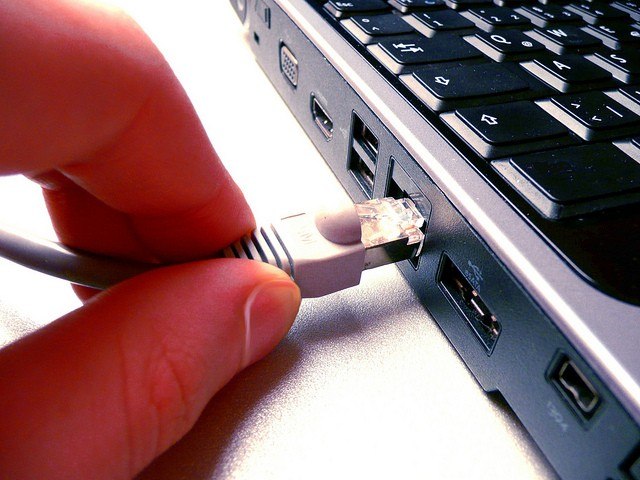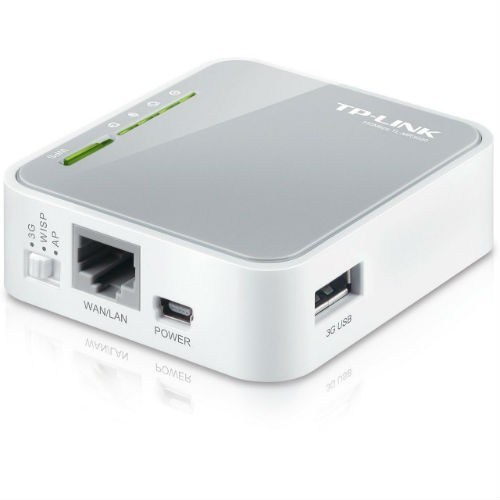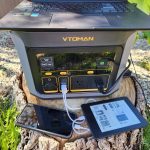This article is part of a new series we’re calling Tech Travels. Each tech post will be an article that revolves around technology and travel. Whether it deals with smartphones and tablets, setting up a portable WiFi solution or going over what devices should be riding shotgun on your travels you’ll find it all here. We’ll also go over must have apps, essential software for a successful blog and everything that tech travel geeks such as ourselves find interesting. If you have anything you’d like to see covered in a future post feel free to Contact Us or leave a comment.

Over the years, we’ve become more and more reliant on a decent Internet connection while we travel. When we first hit the road over ten years ago, personal Internet was a rare luxury. It was always welcome but getting it outside of Internet cafes and hotel lobbies wasn’t often possible. These days, it’s available almost everywhere and because of our jobs, it’s also mandatory.
After spending months in places with only a single wired Internet hookup or only having access to a cellphone data plan, we’ve gotten smarter and have come up with a few good solutions to our Internet problems. Now that we travel with a Tablet, 2 iPhones and a couple laptops, we’ve also found the need to share that Internet connection is just as important. Seeing that we often spend months in one place during our travels, creating our own WiFi Hotspot is one of the first things we do when we get to a new location.
As a result, here’s a list of products and ideas to help share your internet while you’re on the road. I’ve broken them into different categories based upon what’s available, pricing and simplicity to set it up. We’ve used them all at one point or another and they all have their advantages and disadvantages.
In this first installment, I’m going to cover methods involved with sharing a Mobile Broadband Connection (basically a cellphone data plan) and list the pluses and minuses for each one. In my next post on this topic I’m going to list a few different ways to share your wired connection wirelessly (as in how to create an Ad hoc network using only your laptop) and a few products that can simplify your life.
Mobile Internet or Mobile Broadband
The rise of smartphones over the past few years has lead to a greater demand of mobile wireless data plans. A mobile data plan is typically associated with cellphones however telecom companies have flooded the market with hundreds of devices that make use of this diverse data stream. Depending on the country you’re in, the prices for this data can be relatively cheap or relatively expensive. Data in North America is generally much more expensive than the rest of the world but prices seem to be constantly dropping everywhere.
The technology in this post includes 3G, 4G, LTE, Edge, UMTS, CDMA, HSPA, GSM and other similar data mobile telecommunication technologies. For simplicity sake, I will be referring to them all as 3G since this is the most widely used term in regards to mobile data. Please be aware that different carriers in different countries use different bands and technologies to deliver that data and as a result no single product will work in every country around the world. Even the best “World Phone” will be useless in certain places. When figuring out which product is best for your scenario, please keep that in mind. For a general list of Frequencies and Bands please see this informative (though very dry) article.
Now that I got that out of the way, these days there are several ways to access this mobile data stream. Click on any of the following to go directly to their area. Mobile Phones and Tablets with 3G are by far the most common however USB Mobile Internet Sticks (small USB stick’s with a SIM in them) are also becoming popular. There are also Dedicated 3G Routers such as MiFi with built in SIM card support and even standard routers that will accept a USB stick. Some laptops even come with built in mobile broadband modems. For those who live solely on their laptops there’s also <>PCMCIA or ExpressCard solutions. For the most part those are similar enough to their USB counterparts so I’ll just include them there.
Besides for these devices, to get online you will need to purchase a SIM card and subscribe to some sort of data plan to use them. Most countries allow you to buy a SIM card with a cheap data plan included and this is usually the cheapest route to go. Roaming charges outside of your home country while using your current SIM card can be ridiculously costly and using your normal SIM while traveling should usually be avoided.
Smartphones and 3G Tablets
Availability: Everywhere
Budget: Cheap to costly depending on the model you buy
Simplicity: Fairly simple to use and set up
Popular Brands: Apple iPhone, Samsung Galaxy, Nokia Lumia, Blackberry Bold
Almost all newer cell phones (and 3G Tablets) have the ability to share a data connection with others. All it really requires is a phone or tablet with a data plan and one of several built in tools like the built in Personal Hotspot feature on newer iPhones and iPads or MyWi on older ones. On Android devices there are lots of options including free apps like Wireless Tether for Root Users, WiFi HotSpot and the beloved FoxFi. Blackberry devices running OS 7.1 and newer have this option built in as well as most Windows Phones.
Most of these programs let you use your device as a WiFi Hotspot or via Bluetooth to share your Internet with nearby devices. Be aware that running a mobile hotspot takes a lot of power and can often quickly kill the batteries. Phones also usually have a limited WiFi broadcast range and speed is often dependent on the quality of the device as well as the plan it’s on.
Data tethering can include both wireless transmissions and also plugging your phone into a computer (usually via USB) and using it like an old fashioned modem. This last method limits your wireless options however it takes the work off your phone and transfers it to your computer. This can greatly increase your range and also allows your phone to be charged while it’s plugged so when you’re ready to leave all you need is to unplug it and it’s ready to go. Of course, it also requires a computer that is running for as long as you need Internet access. If you’re sharing your Internet with more than the computer then you would also need to set up an ad hoc WiFi network via your computer or use a router.
Pros: Nearly everyone already owns a smartphone or a tablet and they’re easily portable. Internet goes with you wherever you go and if the data plan includes voice then can also be used to make calls and send texts. Some phones and tablets allow you to use Bluetooth as well as WiFi to connect to other devices. Most can also be tethered via USB and act as a modem when plugged into a computer.
Cons: Generally requires the phone to be unlocked and mutli-banded if using a SIM card from a different carrier than the one you bought the phone through. Using it as a WiFi hotspot also depletes batteries quickly. Data network only works as long as the cellphone is present so might not be practical for couples or larger groups who split up from time to time. Most phones only accept up to 5 wireless connections at a time. Transfer speeds between devices connected to the phone can be horrendous. Some carriers limit tethering abilities or charge an additional fee if used as a hotspot.
3G USB Sticks, USB Modems and Mobile Internet Sticks
Availability: Online and nearly everywhere cellphones are sold
Budget: Older models (with slower 3g speeds) are very cheap and newer models can get up in price though they’re still fairly reasonably priced when comparing to a new smartphone.
Simplicity: Moderate to Complex to set up and operate
Popular Brands: Sierra Wireless, Huawei, CradlePoint, ZTE
A USB Mobile Internet Stick is a simple way to use the power of a mobile data plan without the need to have a cellphone. Because they’re much simpler than a cellphone, they’re much cheaper as well. All they need for power is a computer with a USB port or a router that supports USB devices.
Because of their design, they’re small, portable and usually unlocked from the get go. If locked to your home carrier, most can be unlocked for use on any network for a lot less than most phones and if they run into problems, you always have your more expensive smartphone to fall back on.
Since they require a 3rd party device on which to operate, setting them up can be a greater hassle than the few swipes it takes to tether most cellphones. What they make up for in complexity however, is the greater ability to connect to most networks and the ability to share that connection with more than 5 devices at a time.
If connecting via a computer it makes sense to create an ad hoc network for the rest of your devices and enable ICS (Internet Connection Sharing) on a Windows machine or enable it in Sharing on a Mac. If connecting via a wireless router, once you input your information, it’s simple for all your devices to share your Internet.
Pros: Independent of your phone so you can still use your cellphone for other activities. Can usually get better speeds on a dedicated device than a smartphone. Frees your smartphone from always being in use.
Cons: Requires a separate data plan from your phone and requires a computer or router that is always on to share the connection. Usually harder to find support for them since less popular than cellphones. Though they’re small it’s still more electronics to carry and store.
Dedicated Mobile Wireless Routers, MiFi and 3G Routers (usually with built in SIM slots)
Availability: Online, at some major cellphone carriers and some computer centers
Budget: Moderate to expensive depending on the model
Simplicity: Moderate to Complex to set up and operate
Popular Brands: Novatel MiFi, CradlePoint, Sierra Wireless, Huawei, ZTE
Once mobile telecom companies discovered the amount of money people were willing to spend to have data access outside of their homes, the realization that most people also run numerous wireless devices hit home. This lead to the introduction of routers with built in data capabilities. These routers (usually much smaller than their at home equivalents and providing a shorter transmission range) were designed for the mobile workplace.
The caveat is that all that power in such a small package comes at a premium. Also having to purchase a dedicated SIM and data plan scares most people away. Worried about data overuse, it’s only in the past few years that carriers actually got on board with these routers and most that are sold are still provided by 3rd parties. Most 3G routers sold via carriers are locked to that carrier so finding one unlocked usually involves purchasing online via the internet or from specialty stores.
Mobile Internet users that travel an extensive amount usually own these devices and are willing to pay whatever they ask to have the ability to travel unfettered. This has kept their prices at a premium however with more carriers on board the data train the quicker the prices are falling.
These routers offer users the ability to have a dedicated mobile hotspot with minimal down time and easy Internet sharing. They also double as regular routers with the ability to connect to wired networks thereby creating their own wireless system without needing to pay expensive data charges in places that provide free Internet.
Pros: Independent of your phone so can still use your cellphone for other activities. Can usually get better speeds on a dedicated device than on a smartphone. Frees your smartphone from always being in use. Doesn’t require a USB mobile stick to operate (SIM is inserted directly into the router). Can be connected to a wired network when one is available or used as wireless access point if a wireless signal exists but is too weak for some of your wireless devices to use. Since it is a router it will have better security, more connection options (Wireless N, G and B) and faster wireless speeds between devices than using a cellphone.
Cons: Requires a separate data plan from your phone and most routers require access to a power source. Usually harder to find support for them since they’re less popular than cellphones. Expensive compared to non integrated wireless routers.
Wireless Routers with USB 3G Abilities (requires a separate 3G USB Stick)
Availability: Online and at most computer centers
Budget: Cheap to expensive depending on the model
Simplicity: Moderate to Complex to set up and operate
Popular Brands: TP-Link, D-Link, Trendnet, Cradle Point, Novatel, Sierra Wireless, Huawei, ZTE
Mobile data capabilities have been slow coming to the average router. Though carrier support is minimal, this has also kept the costs down. The latter is the best reason for going this route over buying a dedicated Mobile Data router. Just like your home router, these come in all shapes and sizes though there are a few that can can be considered tiny. The biggest difference from your home router is that these devices include both a USB port and the necessary hardware and firmware to run a 3G Mobile USB stick. This frees your laptop or computer from having to be always on and allows you to take your phone with you when you leave without having to reconnect your wireless hotspot when you come back.
The biggest draw back is that you still need a 3G USB stick to share the love and not all routers support every Mobile Stick on the market. Unlike the dedicated 3G routers with the built in SIM abilities, these routers can often be upgraded to faster speeds like 4G LTE with a simple firmware upgrade and a different USB stick (which are generally much cheaper than buying a whole new dedicated router).
Pros: Independent of your phone so can still use your cellphone for other activities. Can usually get better speeds on a dedicated device than a smartphone. Frees your Smartphone from always being in use. Can be connected to a wired network when one is available or used as wireless access point if a wireless signal exists but is too weak for some of your wireless devices. Since it is a router it will have better security, more connection options (Wireless N, G and B) and faster wireless speeds between devices than using a cellphone. 3rd party firmware support in the form of OpenWrt or DD-WRT is excellent. Usually much cheaper than the integrated 3G routers included above.
Cons: Requires a USB Mobile Internet Stick (see above) to operate if a wired network is not available. Requires a separate data plan from your phone and most of them require access to a power source. Usually harder to find support for USB sticks since less popular than cellphones. Slightly more expensive than traditional home routers. Mobile connections can sometimes be fickle.
Laptop with Built-In Mobile Broadband
Availability: Online and at some computer centers
Budget: Expensive compared to the alternatives unless already included in your current laptop
Simplicity: Moderate to set up and operate
Popular Brands: Dell Latitude, HP Elitebook, Lenovo Thinkpad, Panasonic Toughbook, Sony Vaio
Having a built-in 3G or 4G LTE Mobile Broadband device in your new laptop is becoming more and more popular these days. Computer companies are realizing that users want to be mobile but still connected to the net. Usually included for a moderate cost as an addon to a select group of systems, these integrated PCI Express Mini Cards work the same way as the 3G USB sticks without having to use up a USB port or worrying about extra peripherals.
The biggest downside to these built in cards is worldwide support in other countries and the fact that as technologies leap forward, your existing card could be left behind. Though they are becoming more common, the vast majority of new systems don’t even give you the option of including them and finding after market cards that will work properly with an existing system isn’t as easy as you would expect. They also require a free slot which most laptops don’t have.
Just like when using a 3G USB stick, in order to share your Internet, you’ll either need to run an ad hoc network or connect your laptop to a router.
Pros: Independent of your phone so can still use your cellphone for other activities. More consistent speeds than a smartphone. Frees your Smartphone from always being in use. Can be connected to a wired network when one is available or used as wireless access point if a wireless signal exists but is too weak for some of your wireless devices. Can be set up as an ad hoc network with ICS to easily share Internet connections
Cons: Requires a separate data plan from your phone. Costly if you already own a laptop and want to upgrade to this. You always have to leave your laptop running to have Internet on other devices. Can slow down your laptop if there are numerous devices connected to it at once. Accessing the SIM card (if there is one) can be a chore if you are traveling and decide to purchase a SIM card in that country.
ExpressCard Modems, PCMCIA Cards and Similar Devices
These cards are usually already found inside certain laptops with mobile abilities (see above) or can be purchased separately depending on your needs. For all intents and purposes, they act the same as a Mobile USB stick. Certain routers and computers have the necessary ports to use them however I’ve found that they aren’t widely found in most consumer products. Large companies tend to use them since, not only do they buy them cheaper in bulk, but they can be inserted directly in the router or machine with less chance of being stolen or broken. This isn’t because they’re more robustly designed but because they are less compatible with other systems or are generally hidden from site.
I didn’t include them as an option simply because they’re generally more expensive than their USB counterparts and are much more difficult to find for your average consumer.
That being said, if your router or laptop supports one of these devices, then they are definitely viable options. Just realize that support and availability will be a concern and that not all countries will carry them. There’s also a greater chance that your next laptop or router purchase might not have an available slot and you would be forced to buy something else. For sheer compatibility, I suggest sticking with a USB stick for now.
Final Notes
With so many options out there to share your Mobile Internet while on the road, there is bound to be the right solution for you.
A solo traveler that lives on their cellphone might find that using it as a mobile hotspot or tethering their laptop to their phone is the best answer while a larger family or group might find an dedicated wireless router with a built in SIM slot to be perfect for their needs. Whichever way you go, cost, hassle, future upgrade ability, frequency band support and your own needs need to be considered when deciding on the proper hardware.
If you’re wondering which way we go then I have to say I took the cheapest option available to me. We purchased a 3G USB stick a few years ago, paid a small fee to unlock it and now it works in most places around the world. After getting tired of continually setting up an ad hoc setup via our laptop with ICS enabled I finally ordered a cheap router with 3G USB support and haven’t looked back. If I was starting fresh today I would probably just buy a portable, dedicated router with a built in SIM slot like the MiFi or a Cradlepoint router and be done with it.
Besides for going the router way, we still tend to tether our phones if it’s a short trip and if we haven’t purchased a dedicated data plan. So it’s proof positive that no way is the right way for all scenarios and it’s up to you to figure out your own solution.
Stay tuned for an upcoming post where I go over different router configurations and show you how to set up your own ad hoc WiFi network using nothing but your laptop and ICS.







